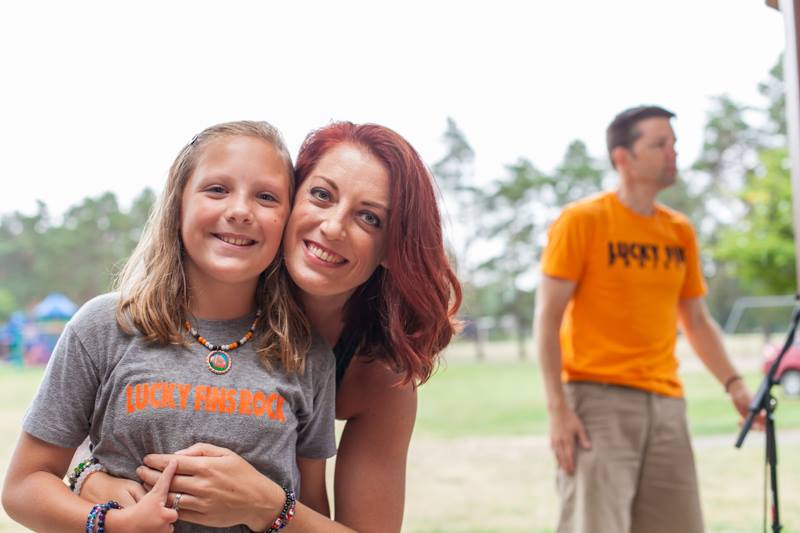About Us
Watch the Lucky Fin Documentary Film by 97films by clicking on the image below.

Celebrating the wonderfully made one “Lucky Fin” at a time.
In 2007 I gave birth to a healthy baby girl named Ryan. As much as each baby is unique, Ryan entered the world with an unexpected hand difference. The growth of her right hand had been stunted, her palm small and no fingers except a tiny thumb. We received painfully little information from health care professionals and my husband and I were left to search for answers on our own. Since then we now know that Ryan’s hand difference is known medically as Symbrachydactyly.
If you’ve seen the movie “Finding Nemo” then you know all about Nemo’s “lucky fin” and how being made a little differently doesn’t stop him from accomplishing anything he sets out to do. In July of 2010 I began making limb difference awareness bracelets in celebration of my daughter as well as all the other individuals in the world with a limb difference. In the last 8 years I’ve made over 20,000 awareness bracelets which have been sent to supporters worldwide and the Lucky Fin love continues to spread daily.
I believe everybody is different. Some people’s differences are on the outside and easier to see than the differences others have on the inside. But EVERYBODY has got something and God doesn’t give challenges to those who can’t handle them. And in what ever your challenge, is a blessing worth celebrating.
“A child being born with a limb difference is not tragic. It’s extremely important to show our children how capable & wonderfully made they are. If we treat them as flawed or limited that is who they will believe themselves to be- and that would be the tragedy.” -Molly Stapelman, founder.
The Lucky Fin Project is a 501(c)(3) nonprofit organization that exists to raise awareness and celebrate children and individuals born with symbrachydactyly or other limb differences (upper, lower, congenital, and amputee).
What We Do:
• Creates a support network for parents across the U.S. and around the world.
• Links parents to medical information and resources.
• Provides education on limb differences.
• Hosts events and financially support efforts for children attend specialized camps, obtain prosthetics, and to fund other organizations within the limb different community.
The Lucky Fin Project has published awareness brochures for distribution to hospital Labor & Delivery wards, birthing centers, Obstetricians, Pediatricians, Orthopedists, and parents.
What is Symbrachydactyly?
Taking the word literally, “sym” means joined (like “syn”), “brachy” means short and “dactyly” means finger. So, the word means “Short joined fingers.”
Symbrachydactyly (sim-brak″e-dak´tĭ-le) occurs during normal embryonic development. When a baby’s hands begin to form in utero, they are shaped like mittens or paddles. Then the fingers divide. In babies with symbrachydactyly, the fingers (and sometimes the hand and arm) don’t fully form during this time. This may happen because the area doesn’t get enough blood flow or because of some other problem with the tissue. It’s not caused by anything the mother did or did not do while she was pregnant.
This hand disorder characterized by abnormally short fingers that are sometimes webbed or conjoined. Most children with symbrachydactyly have the “short finger” type in which the thumb is essentially normal but the remaining fingers are short, stiff and may be webbed. In other cases, only the thumb or the thumb and little finger are present. In more severe cases, all fingers are missing and small nubbins of skin and soft-tissue (little stumps) are located where the fingers would have developed. Research continues into further understanding why this happens.
This limb difference occurs in every 30,000 to 40,000 births. It’s not passed down in families (inherited). If you have a child with symbrachydactyly, you are not at any greater risk of having another child with the condition.
There are 7 different classifications of symbrachydactyly. Nubbins, one of the classic findings in symbrachydactyly, can be present with any of these except the short finger type.
1.short finger
2.cleft type (thumb and small finger present)
3.peromelic (nubbins)
4.monodactyly (only the thumb present)
5.wrist bones present (but nothing more distal)
6.wrist bones absent (ie, arm ends at the end of the forearm)
7.transforearm (amputation at mid forearm level)
